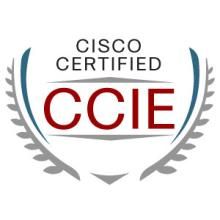What is CCIE?
CCIE is Cisco's top certification (CCA is too high for everyone, so CCIE is the top certification). It is divided into six directions: route switching, security, carrier, voice, wireless, storage. CCIE is known as the Cisco Certified Internet Technology Specialist, so CCIE is positioned at the expert and architect level, and is the largest in terms of certification difficulty and knowledge. The purpose of CCIE certification is to enable certified individuals to have the ability to design, deploy, and deploy large enterprise networks and carrier-grade networks. Note that it is designed, not just deployment. At present, the number of CCIEs in China is less than 4,000, and there are more than 30,000 people worldwide. Everyone who passes CCIE has a CCIE number, starting with 1024. It is generally considered that the 4-digit CCIE is an older person.
Why study CCIE?
CCIE is a symbol of the level of network technology experts, but also the requirements of enterprises for architecture designers. The demand for CCIE comes from three reasons: First, CCIE certification is a symbol of expert technology and one of the important criteria for enterprises to screen and judge talents. Second, CCIE is a prerequisite for Cisco agents to make their own. For example, if a company wants to apply for a gold agent, it must have the required number of CCIEs. Third, due to the general recognition of CCIE, CCIE is also the standard for customers to judge a company's strength. Therefore, for network related practitioners, if you want to have a better career development, CCIE is not a must, but it is a very effective accelerator.
How do we view CCIE?
Whether CCIE is useful or not is a topic that many people often argue. In fact, there is only one reason for this controversy. CCIE also has Paper. The so-called paper is backed up by the back question bank. I have seen many CCIEs and no CCNP level. Therefore, it triggered a series of disputes about the CCIE gold content and CCIE wages. Let me talk about my definition of a true CCIE.
First, don't ask everyone to understand, but at least there is no technology on the network that you haven't heard of.
Second, after contacting the actual project and understanding the actual production environment of the enterprise, at least 2~3 comprehensive, complex applications and large-scale network projects have been done.
Third: Each technology of CCIE is the most basic requirement, and another requirement of CCIE is architecture design capability. I often say a word: A qualified teacher can tell you what it is and how it is achieved. A good teacher can tell you why there are this technology and the difference between it and other technologies. Therefore, design ability and troubleshooting ability are the requirements of a true expert.
Fourth: It can't just be a network. IT itself is a composite industry. No technology is independent and has no connection with each other. I have never heard of a real network expert who does not understand the operating system, does not understand Linux, does not understand the database, Do not understand development. You are not required, but at least you have to have a general understanding of the entire IT industry. So everyone's definition of CCIE is not too narrow. It is not difficult to pass CCIE. It is rare to become a real CCIE. Only when you become a real CCIE, can you make money? Or the old saying: The company wants people who can solve problems, not a pair of certified but can't do live vases.
Introduction to the CCIE exam
CCNA and CCNP certification are not required to take the CCIE exam. The exam is divided into 2 stages, written test and Lab test. The written test can be taken at the SPOTO VUE Center, with a score of 1000 and 729. The lab has only 10 test sites around the world, and China in Beijing and Hong Kong. There is no opportunity to retake the exam. There is only one part of the written test, which covers all the contents of the relevant direction outline. The trial was divided into three parts: interview, troubleshooting, Lab test; interview: route exchange and voice direction interviews have been canceled. Early interviews are interviews for real people. 4 questions, at least 3 answers, all in English. Later changed to a full English answer on the computer (not to mention, hit it out). If the interview is not passed, even if the score is not used later; troubleshooting: fixed 2 hours of troubleshooting time, requiring troubleshooting of a configured network.

 Join Telegram Study Group ▷
Join Telegram Study Group ▷














